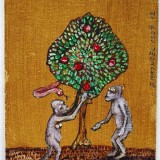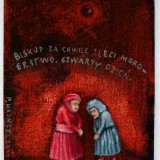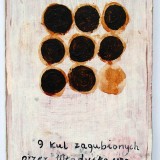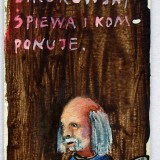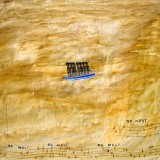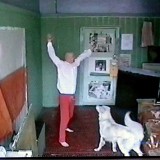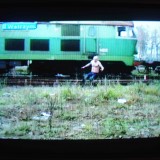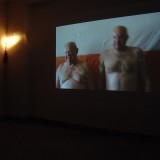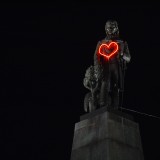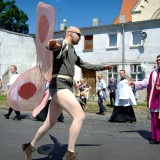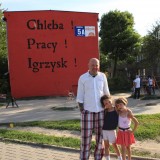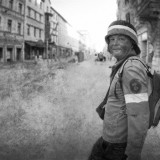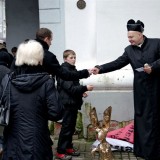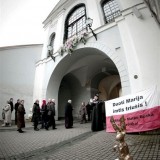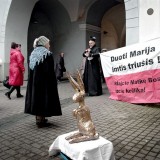Pawe³ Hajncel
Pawe³ Hajncel was born in £ód¼ in 1967. He created some DIY art from early childhood which he spent in £ask and he currently lives in £ód¼. He is one of the most rebellious and uncompromising contemporary artists. At the same time he is also auto-ironic and endowed with a sense of humour. He has created drawings and illustrations (in co-operation with Przekroj weekly) which are inspired by Polish social, political and cultural life and has organised actions / civic interventions in the public environment.
A decisive influence on the shaping of Pawe³ Hajncel’s progressive stance of was his contact with the International Collection of 20th Century Art in the Art Museum in £ód¼. There as a 19-year old he watched a film report about the theatrical performance by Tadeusz Kantor Wielopole, Wielopole (1981), which he recalls as follows: “It had a fundamental effect on me. It freed me from every imposed visual form and more. I understood that art is not subjected to anything, it’s free to it no borders apply. I still think the same.” A similar discovery was the works Polentransport by Joseph Beuys, German Neue Wilde painting from the 80s and… German romanticism. They allowed him to find his own expression, internal tension and temperament, which was best expressed in miniature paintings from 2008-2011 and recently in the small cardboards painted with emulsion paint and aquarelle (Little Cardboards, 2009-2013).
Using a witty deformation and the grotesque, Pawe³ comments on current events, such as the Smoleńsk catastrophe, the purchase of F-16 fighters by the government, corruption scandals and the life of pop culture celebrities. He courageously demythologises and deconstructs artistic sanctities for example by drawing the images of Adam Mickiewicz, Fryderyk Chopin, Zofia Na³kowska, Andrzej Sikorowski or Apollo (Antique memories, 2010). He fights the constructivist myth (Malewicz is walking, but he stopped; 9 bullets lost by W³adys³aw Strzemiński in 1949, 2012) and the myth of abstractionism (I have to start liking abstract art this year, 2009), he is unforgiving of the cult of the kings in the Republic of Both Nations by creating his own, turpist pictorial guide (Sigismund August, Sigismund the Old, Sigismund Vasa III) and in the work great Poles (Lech Wa³źsa switches a channel to Theatre TV, 2012). With equal irony he shows his auto-portraits, close in style to masks from medieval beast-books.
To summarise, Little Cardboards is a series which is aesthetically aware, synthetic in its form, focused on the casuality of painterly gesture and the expression of brush stroke. The text comments are used almost in the entire series, as a word completes the image and sometimes is even superior, like in the series about a bishop. Among the newest illustrative works by Pawe³ Hajncel one should list illustrations to the Magic Mountain by Thomas Mann, currently uploaded on the artist’s page on Facebook and his treating of wooden elements found in the rubbish as background for works of art. The artist is able to creatively use each format, structure and texture, taking out of them the most interesting technical qualities, although the most important for him is the density of the references in the statement.
Art is for Pawe³ Hajncel a way to communicate with and confront Polish society, prosecuting the absurd deeds and stupidity of decision-makers, religious functionaries and the cultural elite. That’s why since 2007 a parallel means within his artistic expression has been civic actions/inventions, as he describes them himself, which take place in the public environment and are usually photo or video-documented. The actions are directed by the artist, but there are always elements of surprise and accident, which result from the spontaneous reaction of viewers, who are usually favourable to him and enter into the arranged situations. The first event of such type was a performance Rafa³ Ziemkiewicz is only a fantasist (2007), but the turning point was the Butterfly-man from 2011, the artist’s commentary upon the Corpus Christi procession in front of the archiepiscopal church in £ód¼. Joining the religious celebration devoted to John Paul II which was taking place in front of the church in £ód¼, Pawe³ Hajncel appeared with the banner: “This is not my father”. In this way he protested against the appropriation of the public space by defined social groups which impose their point of view and lifestyle on other citizens in a lay country such as Poland.
The artist was prosecuted by the public prosecutor’s office several times. This fact, was noted by the media, Internet, press and TV and helped to boost up the public discourse over the dependencies between the state, religion and citizen. Pawe³ Hajncel won a hard battle with Polish obscurantism, the avalanche goes on and today he is being asked to do similar interventions in other towns, for example in Lublin. On December 10th 2013 he organised an action entitled Free art which was a response to the decision of local authorities of Lublin to finance from 2013-2020 only the art which would be in accordance with the rules of the Decalogue. His was dressed in white, hooded overalls (although most often he wears white and red like the Polish flag), a muzzle on his mouth and a box with the iconography of the Decalogue. He also presented an interesting intervention in 2013 in Vilnius – on front of the The Gate of Dawn he hung a banner saying in Polish and in Lithuanian: “Give our Holy Mary back, take a rabbit!” Dressed up as a priest he called through a megaphone for an exchange, in his opinion – an attractive one – a Holy Mary image, famous for its miracles, a catholic relic and the goal for pilgrimages of Poles to Vilnus in exchange for a golden rabbit. It was supposed to be an exchange of a gold calf for a gold calf. Above all it was a protest against Polish nationalist trips to Vilnius, which are a serious problem that influence Polish-Lithuanian relationships and a reaction towards a banner hung above one of the Polish stadiums: “Lithuanian boar, kneel in front of the Polish master.” Lithuanian police showed a sense of humour and understanding, by arresting the artist but let him go free without any legal consequences.
Pawe³ Hajncel’s projects also deal with topics associated with the Polish national liberation movement in history. An example of such work was an action dedicated to the 69th anniversary of the outbreak of the Warsaw Uprising, organised on August 1st 2013 in Piotrkowska St. Dressed up as a small insurgent and shooting from a percussion-cap gun, he ran around the representative promenade in £ód¼ asking passers-by and guests in the beer-gardens to join him in the insurgent fights. He provoked them by asking if they were ready to die for their fatherland or if they would send their kids to fight for the country. This is also an element of the discourse within national myths and the voice in the discussion on the justification of uprisings in which millions of people died. The Uprising, just like many other of Pawe³’s actions was filmed, although the artist usually does not use other’s people’s help, trying to be as self-sufficient as possible. He also makes most of his props and costumes himself, and also finances his own projects, although the great social response which he has gained since the Butterfly-man action has resulted in many sponsorship proposals. The artist tries to remain independent and non-commercial. He summarises his stance: I am always in a state of process, I do DIY, I don’t focus on one medium or one technique. Thanks to that I am totally free, I don’t impose anything on myself. I do what I want and I take what I want from current reality. span>
Monika Nowakowska


